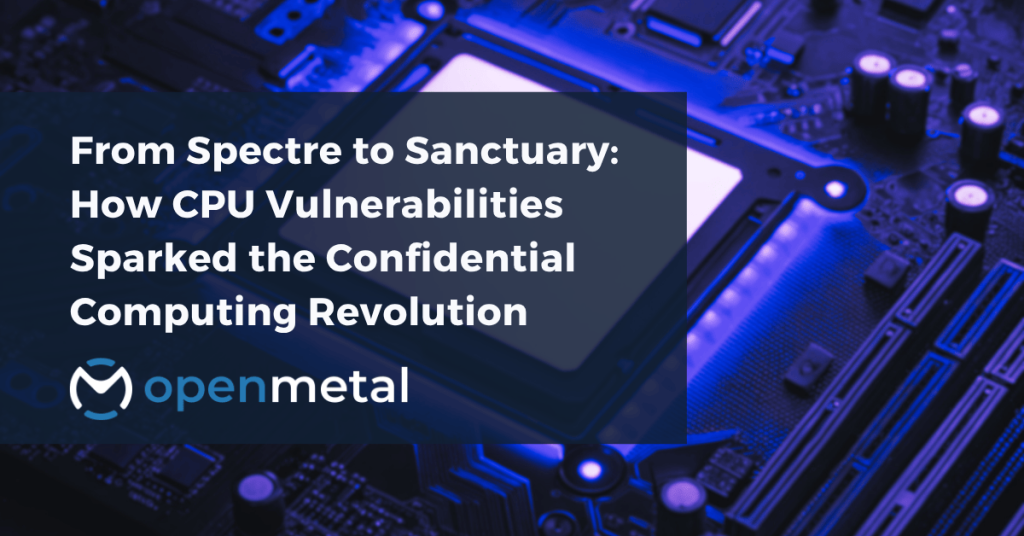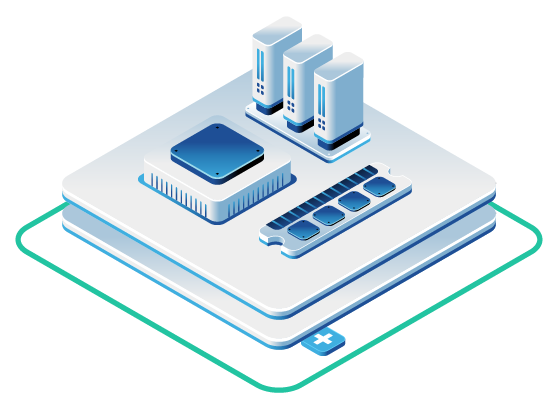
Ready to explore bare metal infrastructure with confidential computing capabilities?
OpenMetal’s v4 enterprise servers with Intel TDX support deliver hardware-enforced security on open, transparent infrastructure.
Key Takeaways
- The 2018 Spectre, Meltdown, and Foreshadow vulnerabilities exposed fundamental flaws in CPU architecture that broke decades-old assumptions about hardware isolation and trust
- These attacks demonstrated that performance optimizations like speculative execution created exploitable side channels, forcing the industry to rethink the relationship between speed and security
- Confidential computing emerged as a proactive architectural response, using hardware-based memory encryption to protect data in use, not just at rest or in transit
- Intel TDX represents the next generation of confidential computing, creating isolated trust domains where encrypted workloads remain invisible even to hypervisors and system administrators
- OpenMetal has enabled Intel TDX on select enterprise bare metal servers and is actively researching integration paths for its OpenStack-powered private cloud platform
January 2018 marked a turning point in computing history. Security researchers revealed three catastrophic vulnerabilities—Spectre, Meltdown, and Foreshadow—that shattered fundamental assumptions about processor security. These weren’t ordinary software bugs that could be patched away. They were architectural side channels baked into the silicon itself, born from decades of performance optimizations that prioritized speed over isolation. Within weeks, the vulnerabilities affected billions of devices running Intel, AMD, and ARM processors. The industry scrambled to deploy mitigations, often sacrificing performance to restore security. But the deeper damage was philosophical: if you couldn’t trust the CPU to maintain boundaries between processes, what could you trust?
The answer would emerge over the following years as confidential computing—a fundamental redesign of how hardware protects data during active processing. Today, companies like OpenMetal are building on this movement by enabling Intel Trust Domain Extensions (TDX) on select enterprise bare-metal servers, demonstrating that open platforms and cryptographic privacy can coexist in next-generation infrastructure.
The Ghosts in the Silicon
To understand why confidential computing matters, you need to understand what Spectre, Meltdown, and Foreshadow actually exploited. Modern CPUs don’t execute instructions one at a time—they predict which instructions will be needed next and execute them speculatively, rolling back results if the prediction was wrong. This speculative execution dramatically improves performance, but it leaves traces in the CPU cache that attackers can measure.
- Spectre exploited this behavior by tricking processors into speculatively executing instructions that accessed restricted memory, then measuring cache timing to extract the data. According to the original disclosure by Google Project Zero researchers, Spectre could breach isolation between different applications running on the same system, allowing an attacker to read sensitive information like passwords or encryption keys from other processes (Kocher et al.). The attack worked across virtually all modern processor architectures, making it nearly universal in scope.
- Meltdown took a different approach. It exploited out-of-order execution to access kernel memory from unprivileged user processes. Normally, the CPU should prevent this access and trigger an exception, but Meltdown leveraged the timing gap between when the processor fetches protected data and when it checks permissions. During that microsecond window, the data briefly exists in cache where it can be extracted through side-channel analysis (Lipp et al.). The attack fundamentally broke the isolation between user applications and the operating system kernel.
- Foreshadow, discovered later in 2018, demonstrated that even Intel’s existing security technology wasn’t safe. The vulnerability targeted Intel SGX (Software Guard Extensions), which was designed to create protected enclaves where sensitive code could run isolated from the rest of the system. Foreshadow used an L1 Terminal Fault to extract data from SGX enclaves, proving that first-generation hardware security mechanisms had exploitable weaknesses (Van Bulck et al.).
The immediate response involved software patches, microcode updates, and disabling certain CPU features—measures that often came with performance penalties ranging from 5% to 30% depending on workload. But the patches addressed symptoms, not causes. The industry faced a harder question: how do you redesign processor architecture to prevent these attacks at the hardware level?
Performance vs. Privacy: A New Calculus
For decades, the computing industry operated under an implicit bargain: we’ll make processors faster through aggressive optimizations, and software will maintain security boundaries. Spectre and Meltdown proved that bargain was broken. The very techniques that made modern processors fast—speculative execution, out-of-order processing, complex caching hierarchies—created exploitable information leaks.
The vulnerabilities forced a recalibration. Performance still mattered, but not at the expense of fundamental security guarantees. Rather than continuing to patch architectural flaws reactively, processor vendors began designing proactive security features directly into silicon. The goal shifted from preventing attacks through software isolation to making isolation physically enforced by hardware, even when sharing resources across multiple tenants or untrusted environments.
This shift gave birth to confidential computing: protecting data while it’s actively being processed, not just when it’s stored or transmitted. The concept required rethinking the entire trust model of computing infrastructure.
Confidential Computing: Trust Rooted in Silicon
Confidential computing addresses a problem that traditional security models couldn’t solve: protecting data in use. Encryption has long protected data at rest (on disk) and in transit (across networks), but once data enters memory for processing, it’s traditionally been visible to the operating system, hypervisor, and anyone with administrative access. Confidential computing closes that gap by encrypting memory at the hardware level and controlling access through cryptographic attestation.
Three major implementations emerged from the leading processor vendors. Intel developed Trust Domain Extensions (TDX), AMD created Secure Encrypted Virtualization with Secure Nested Paging (SEV-SNP), and ARM designed its Confidential Compute Architecture (CCA). While implementation details differ, all three share core principles: hardware-based memory encryption, isolated execution environments, and cryptographic attestation to verify the integrity of the computing environment (Confidential Computing Consortium).
The industry formalized this movement through the Confidential Computing Consortium, a Linux Foundation project launched in 2019 that defines standards and promotes adoption. The consortium’s definition emphasizes protecting data in use through hardware-based trusted execution environments, making security verifiable rather than merely asserted.
Intel TDX: Trust Domains Explained
Intel TDX represents the evolution of SGX, learning from Foreshadow’s lessons while scaling to full virtual machine workloads. Where SGX protected small application enclaves, TDX protects entire virtual machines called Trust Domains (TDs). Each TD operates with its own encryption keys managed directly by the CPU, making the TD’s memory cryptographically isolated from the host, hypervisor, and other tenants.
Here’s how it works in practice: When you launch a workload inside a Trust Domain, the CPU generates unique encryption keys that never leave the processor’s secure key management hardware. All memory pages belonging to that TD are transparently encrypted using those keys. Even if someone with physical access to the server pulled the DIMM modules and read their contents, they’d find only encrypted data. The hypervisor can schedule and manage the TD, but it cannot inspect its memory or execution state (Intel Corporation).
TDX also provides remote attestation—a cryptographic proof that a workload is running inside a genuine Trust Domain with specific security properties. Before sending sensitive data to a TD, you can verify its attestation report to confirm the environment hasn’t been tampered with. This makes trust verifiable through mathematics rather than relying on legal agreements or security audits alone.
The architecture solves the fundamental problem that Spectre, Meltdown, and Foreshadow exposed: you can share physical hardware across multiple tenants without requiring trust in the infrastructure provider. The hardware itself enforces isolation, making confidential computing possible even in multi-tenant cloud environments.
OpenMetal: Enabling Confidential Computing on Bare-Metal Infrastructure
OpenMetal operates at the intersection of two movements that rarely converge: open-source infrastructure and hardware-enforced security. The company provides Hosted Private Clouds built entirely on open technologies—OpenStack for orchestration and Ceph for distributed storage—running on dedicated bare-metal servers. Unlike public cloud providers who obscure their infrastructure behind proprietary APIs and metered pricing, OpenMetal gives customers complete visibility into their compute, storage, and networking layers.
This transparency matters because cloud security traditionally required blind trust. You deployed workloads to servers you couldn’t see, managed by hypervisors you couldn’t audit, controlled by administrators you didn’t employ. OpenMetal’s model inverted this: customers got dedicated hardware, open-source software stacks they could inspect, and predictable fixed costs rather than usage-based pricing that incentivized keeping workloads running longer than necessary.
In 2025, OpenMetal enabled Intel TDX on select enterprise bare metal servers, bringing confidential computing capabilities to customers who need the highest levels of hardware-enforced security. OpenMetal’s v4 bare metal servers—including Medium v4, Large v4, XL v4, and XXL v4 models—use 5th Gen Intel Xeon CPUs that support both SGX and TDX (OpenMetal). To enable these features, servers require specific hardware configurations, particularly with system memory: each CPU must have a minimum of one DIMM per memory channel (8 DIMMs per CPU socket), and OpenMetal requires 1TB of total memory for any TDX/SGX enabled hardware to ensure adequate headroom for memory encryption metadata and confidential workload operations (OpenMetal).
Currently, TDX is available on OpenMetal’s enterprise bare metal servers rather than within the company’s OpenStack-powered private cloud offering. However, the broader OpenStack ecosystem is actively advancing confidential computing capabilities. According to the OpenInfra Foundation’s recent white paper on AI infrastructure, OpenStack Nova has supported GPU passthrough since the Icehouse release and continues to evolve support for accelerated computing resources that are critical for confidential AI workloads (OpenInfra Foundation). The white paper demonstrates how organizations worldwide are using OpenStack to build secure, multitenant infrastructure for sensitive workloads—the same use cases that benefit from confidential computing protections.
OpenMetal is researching integration paths to bring TDX capabilities into its OpenStack-powered private cloud platform, exploring how to combine the visibility and flexibility of open-source orchestration with the cryptographic guarantees of Trust Domains. This research reflects a broader industry trend: making confidential computing accessible not just at the bare-metal level but within fully orchestrated cloud environments where customers can deploy workloads with both operational transparency and hardware-enforced privacy.
Think of the current implementation as laying the foundation. OpenMetal’s TDX-enabled bare metal servers prove that confidential computing works on open infrastructure. The next chapter involves extending those protections upward into the orchestration layer, where OpenStack can provision and manage Trust Domains alongside traditional virtual machines. When that integration matures, customers will be able to deploy workloads—AI model training on sensitive datasets, financial analytics, research computing with proprietary algorithms—with both the visibility of OpenStack APIs and the cryptographic isolation of Intel TDX.
The architecture demonstrates an important principle: open infrastructure and confidential computing aren’t contradictory. You can verify how your infrastructure operates through open-source code and transparent APIs while ensuring that specific workloads remain cryptographically isolated at the silicon level. OpenMetal’s bare metal foundation provides dedicated hardware with no noisy neighbors, open-source software stacks that can be audited, and now the option for hardware-enforced memory encryption through Intel TDX. As the company’s research progresses toward full OpenStack integration, this combination will become even more powerful—delivering transparency without exposure, visibility without vulnerability.
The Ghosts Became the Guardians
Spectre, Meltdown, and Foreshadow exposed uncomfortable truths about computing architecture. Performance optimizations we’d relied on for decades created exploitable side channels. Hardware we’d trusted to maintain isolation could leak secrets through microscopic timing variations. Security features we’d built to protect sensitive workloads could themselves be compromised.
But those vulnerabilities also sparked something transformative. They forced the industry to stop treating security as a software problem layered atop hardware and start building protection directly into silicon. Confidential computing emerged not as a patch but as a fundamental architectural redesign—one that makes isolation physically enforced rather than logically asserted.
Intel TDX, AMD SEV-SNP, and ARM CCA represent this new generation of security: hardware that assumes breach, designs for zero trust, and makes confidentiality verifiable through cryptographic attestation. These technologies don’t just mitigate the vulnerabilities discovered in 2018—they reimagine the relationship between performance, isolation, and trust.
OpenMetal’s enablement of TDX on enterprise bare metal servers shows what this future looks like in practice. Open-source transparency meets hardware-enforced privacy. Dedicated infrastructure delivers predictable performance without sacrificing security economics. As the company researches integration with its OpenStack platform, the vision becomes clearer: infrastructure where customers gain both operational visibility and cryptographic confidentiality—seeing how their cloud works while ensuring that sensitive data remains invisible to everyone except authorized workloads.
The ghosts in the silicon taught us that speed without security is illusory. Confidential computing transforms that lesson into architecture. The result is infrastructure where trust isn’t just promised—it’s proven, measured, and sealed in hardware. That’s not the end of the security story, but it’s the foundation on which the next chapter gets written.
OpenMetal’s v4 enterprise servers with Intel TDX support deliver hardware-enforced security on open, transparent infrastructure. Whether you’re running sensitive workloads today or planning for tomorrow’s OpenStack-integrated confidential cloud, discover how OpenMetal combines dedicated hardware, open-source visibility, and cryptographic trust.
FAQ
Q: What’s the practical difference between confidential computing and traditional encryption?
Traditional encryption protects data at rest (on disk) and in transit (over networks), but once data enters memory for processing, it’s typically visible to the operating system, hypervisor, and system administrators. Confidential computing extends encryption to data in use by encrypting memory at the hardware level and restricting access even from privileged software layers. This means workloads can process sensitive data without exposing it to the infrastructure provider or other tenants sharing the same physical hardware.
Q: Which OpenMetal servers currently support Intel TDX?
Intel TDX can be enabled on OpenMetal’s v4 enterprise bare metal servers, including the Medium v4, Large v4, XL v4, and XXL v4 models, all of which use 5th Gen Intel Xeon processors. However, enabling TDX requires specific memory configurations—at least 8 DIMMs per CPU socket and 1TB of total system memory. The XL v4 and XXL v4 models support TDX out of the box with their default configurations, while Medium and Large v4 servers require memory upgrades to meet these requirements. TDX is currently available on bare-metal servers rather than within OpenMetal’s OpenStack-powered private cloud offering.
Q: How does confidential computing performance compare to traditional virtualization?
Modern confidential computing implementations like Intel TDX minimize performance overhead through hardware acceleration of memory encryption. Benchmarks show most workloads experience single-digit percentage performance differences compared to non-confidential VMs, and many workloads see no measurable impact. This represents a dramatic improvement over early software-based approaches and the performance penalties imposed by Spectre/Meltdown mitigations, making confidential computing practical for production deployments rather than just high-security niche applications.
Q: Can confidential computing protect against all CPU vulnerabilities?
Confidential computing specifically addresses vulnerabilities that involve unauthorized access to memory contents, including the classes of attacks demonstrated by Spectre, Meltdown, and Foreshadow. It provides strong protection against malicious hypervisors, compromised operating systems, and physical memory attacks. However, it’s not a complete security solution—you still need secure boot, supply chain verification, network security, and application-level security controls. Confidential computing is best understood as a foundational layer that makes other security controls more effective by ensuring data confidentiality during processing.
Q: When will Intel TDX be available on OpenMetal’s OpenStack private clouds?
OpenMetal is currently researching integration paths to bring Intel TDX capabilities into its OpenStack-powered private cloud platform. While TDX is available today on select enterprise bare metal servers, full integration with OpenStack orchestration is still under development. The broader OpenStack community is actively working on confidential computing support, as demonstrated in the OpenInfra Foundation’s white papers on AI infrastructure and secure multi-tenancy. OpenMetal customers interested in confidential computing for OpenStack workloads should contact the company directly to learn about current capabilities and future roadmap timelines.
Read More Blog Posts
Works Cited
- Confidential Computing Consortium. “Confidential Computing: Hardware-Based Trusted Execution for Applications and Data.” Linux Foundation, https://confidentialcomputing.io/. Accessed 29 Oct. 2025.
- Intel Corporation. “Intel Trust Domain Extensions (Intel TDX).” Intel Developer Zone, https://www.intel.com/content/www/us/en/developer/articles/technical/intel-trust-domain-extensions.html. Accessed 29 Oct. 2025.
- Kocher, Paul, et al. “Reading Privileged Memory with a Side-Channel.” Google Project Zero, 3 Jan. 2018, https://googleprojectzero.blogspot.com/2018/01/reading-privileged-memory-with-side.html.
- Lipp, Moritz, et al. “Meltdown: Reading Kernel Memory from User Space.” Meltdown Attack, https://meltdownattack.com/. Accessed 29 Oct. 2025.
- OpenInfra Foundation. “Open Infrastructure for AI: OpenStack’s Role in the Next Generation Cloud.” OpenStack Foundation, https://www.openstack.org/openstack-for-ai-white-paper. Accessed 29 Oct. 2025.
- OpenMetal. “Enabling Intel SGX and TDX on OpenMetal v4 Servers: Hardware Requirements.” OpenMetal Resources, https://openmetal.io/resources/blog/intel-tdx-and-sgx-requirements/. Accessed 29 Oct. 2025.
- “Spectre Attacks: Exploiting Speculative Execution.” Spectre Attack, https://spectreattack.com/. Accessed 29 Oct. 2025.
- Van Bulck, Jo, et al. “Foreshadow: Extracting the Keys to the Intel SGX Kingdom with Transient Out-of-Order Execution.” Foreshadow Attack, https://foreshadowattack.eu/. Accessed 29 Oct. 2025.


































